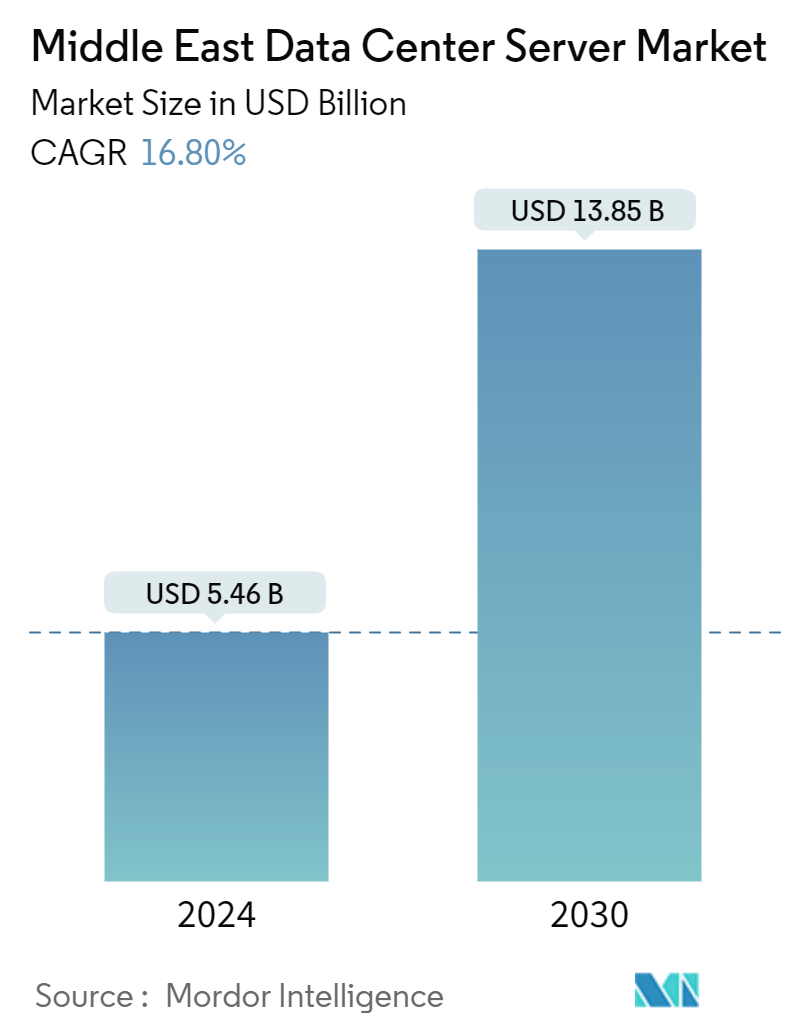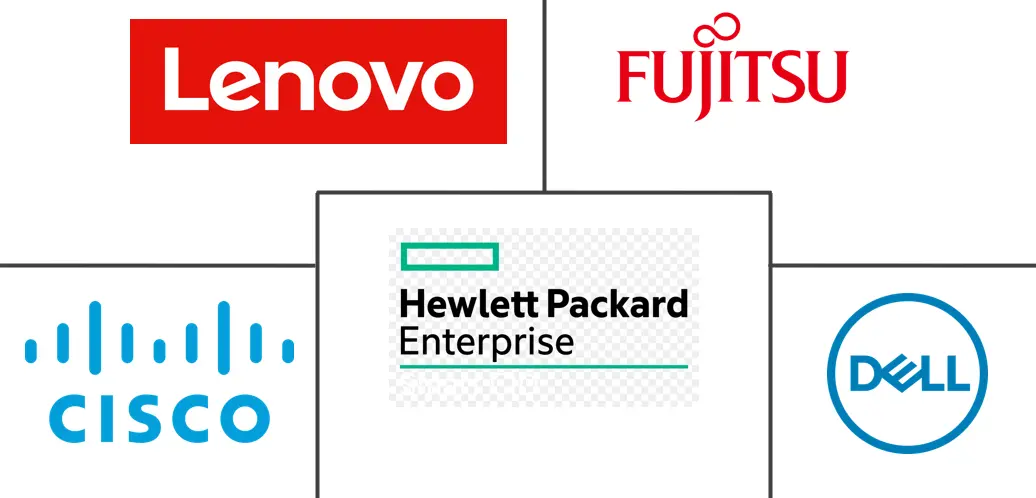Market Size of Middle East Data Center Server Industry

| Study Period | 2019 - 2030 |
| Base Year For Estimation | 2023 |
| Market Size (2024) | USD 5.46 Billion |
| Market Size (2029) | USD 13.85 Billion |
| CAGR (2024 - 2030) | 16.80 % |
| Market Concentration | Medium |
Major Players
*Disclaimer: Major Players sorted in no particular order |
Middle East Data Center Server Market Analysis
The Middle East Data Center Server Market size is estimated at USD 5.46 billion in 2024, and is expected to reach USD 13.85 billion by 2029, growing at a CAGR of 16.80% during the forecast period (2024-2029).
The increasing demand for cloud computing among SMEs, government regulations for local data security, and growing investment by domestic players are some of the major factors driving the demand for data centers in the region.
- The upcoming IT load capacity of the Middle East data center construction market is expected to reach 2,059.5 MW by 2029.
- The region's construction of raised floor area is expected to increase 9.7 million sq. ft by 2029.
- The region's total number of racks to be installed is expected to reach 496K units by 2029. Saudi Arabia is expected to house the maximum number of racks by 2029.
- There are close to 26 submarine cable systems connecting the Middle East, and many are under construction. One such submarine cable that is estimated to start service in 2024 is Blue, which stretches over 4,696 Kilometers with a landing point in Tel Aviv.
Middle East Data Center Server Industry Segmentation
A data center server is basically a high-capacity computer without peripherals like monitors and keyboards. It is a hardware unit installed inside a rack, having a central processing unit (CPU), storage, and other electrical and networking equipment, making them powerful computers that deliver applications, services, and data to end-user devices.
The Middle East data center server market is segmented by form factor (blade server, rack server, tower server), by end user (IT and telecommunication, BFSI, government, media and entertainment, and other end users), and by geography (Saudi Arabia, United Arab Emirates, Israel, and Rest of Middle East). The market sizes and forecasts are provided in terms of value (USD) for all the above segments.
| Form Factor | |
| Blade Server | |
| Rack Server | |
| Tower Server |
| End-User | |
| IT & Telecommunication | |
| BFSI | |
| Government | |
| Media & Entertainment | |
| Other End-User |
| Geography | |
| Saudi Arabia | |
| United Arab Emirates | |
| Israel | |
| Rest of Middle East |
Middle East Data Center Server Market Size Summary
The Middle East data center server market is experiencing significant growth, driven by the increasing demand for cloud computing, government regulations on data security, and substantial investments from local players. The region is witnessing a surge in the construction of data centers, with a notable expansion in IT load capacity, raised floor area, and the number of racks, particularly in Saudi Arabia. The adoption of cloud-based services is propelling the growth of wholesale and hyperscale colocation services, necessitating more space and servers in data centers. The rapid evolution of data processing, analysis, and storage technologies is becoming essential for countries with digital transformation strategies, further fueling the demand for data center servers. Investments from major cloud service providers like Google and Oracle are also contributing to the market's expansion, with initiatives such as Oracle's partnership with NEOM Tech & Digital Hold Co. in Saudi Arabia.
The telecom sector's dominance, driven by the adoption of 5G networks and the expansion of digital payment systems, is expected to bolster the demand for data center servers. Saudi Arabia's ambitious smart city projects and digital transformation initiatives are creating a substantial need for data storage and processing capabilities. The country's strategy to establish a nationwide network of large-scale data centers, supported by local firms, is a testament to this growing demand. The increasing internet penetration, e-commerce growth, and the shift towards digital payments are further propelling the market. Major players like Dell Inc., Hewlett Packard Enterprise, and Cisco Systems Inc. are actively expanding their presence in the region, introducing next-generation servers and technology solutions to meet the rising demand. These developments are set to drive the Middle East data center server market's growth in the coming years.
Middle East Data Center Server Market Size - Table of Contents
-
1. Market Dynamics
-
1.1 Market Overview
-
1.2 Market Drivers
-
1.2.1 Increasing Adoption of Cloud Technologies
-
1.2.2 Large-scale commercialization of 5G networks
-
-
1.3 Market Restraints
-
1.3.1 Rising CapEx for data center construction
-
-
1.4 Value Chain / Supply Chain Analysis
-
1.5 Industry Attractiveness - Porter's Five Forces Analysis
-
1.5.1 Threat of New Entrants
-
1.5.2 Bargaining Power of Buyers/Consumers
-
1.5.3 Bargaining Power of Suppliers
-
1.5.4 Threat of Substitute Products
-
1.5.5 Intensity of Competitive Rivalry
-
-
1.6 Assessment of COVID-19 Impact
-
-
2. MARKET SEGMENTATION
-
2.1 Form Factor
-
2.1.1 Blade Server
-
2.1.2 Rack Server
-
2.1.3 Tower Server
-
-
2.2 End-User
-
2.2.1 IT & Telecommunication
-
2.2.2 BFSI
-
2.2.3 Government
-
2.2.4 Media & Entertainment
-
2.2.5 Other End-User
-
-
2.3 Geography
-
2.3.1 Saudi Arabia
-
2.3.2 United Arab Emirates
-
2.3.3 Israel
-
2.3.4 Rest of Middle East
-
-
Middle East Data Center Server Market Size FAQs
How big is the Middle East Data Center Server Market?
The Middle East Data Center Server Market size is expected to reach USD 5.46 billion in 2024 and grow at a CAGR of 16.80% to reach USD 13.85 billion by 2029.
What is the current Middle East Data Center Server Market size?
In 2024, the Middle East Data Center Server Market size is expected to reach USD 5.46 billion.

